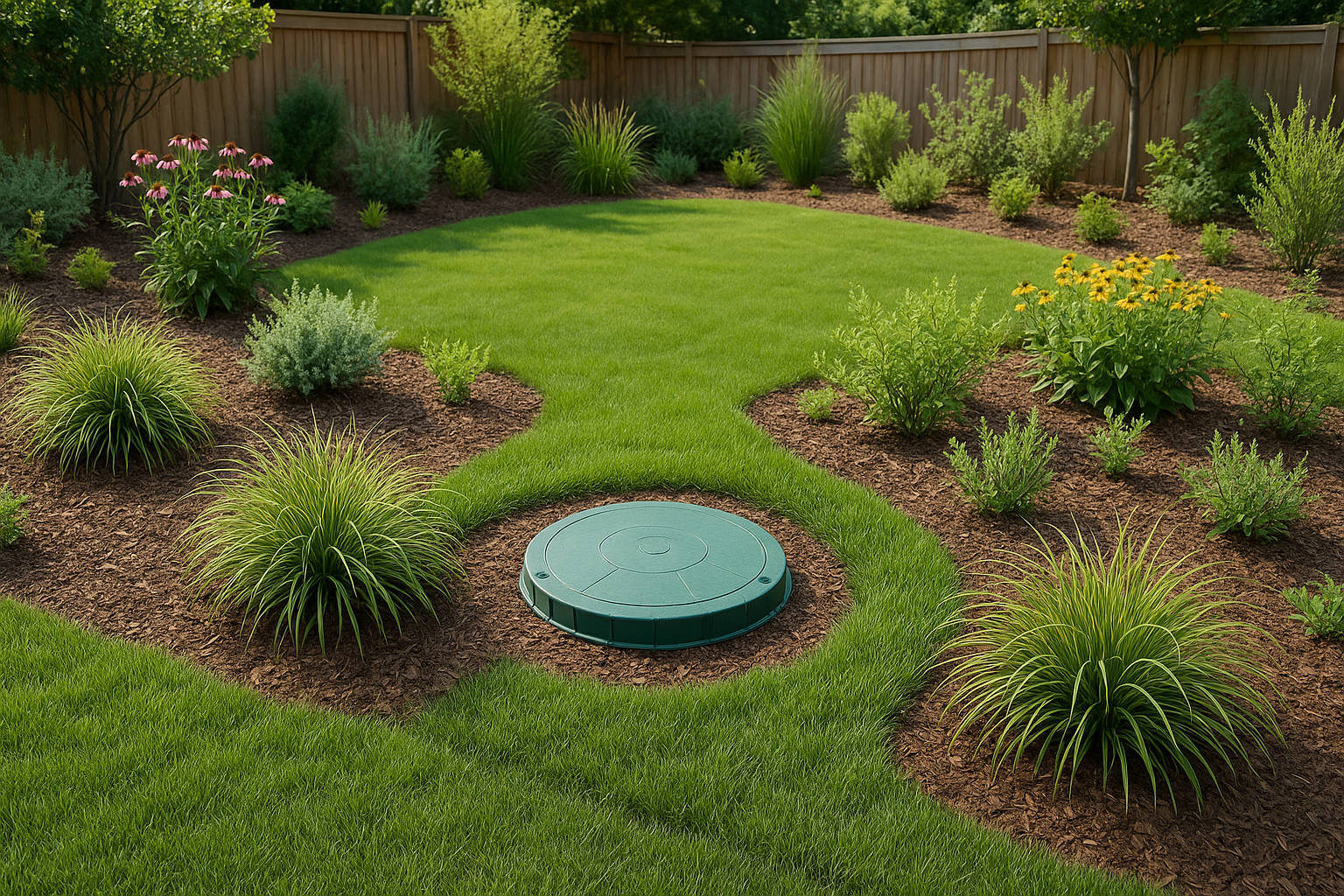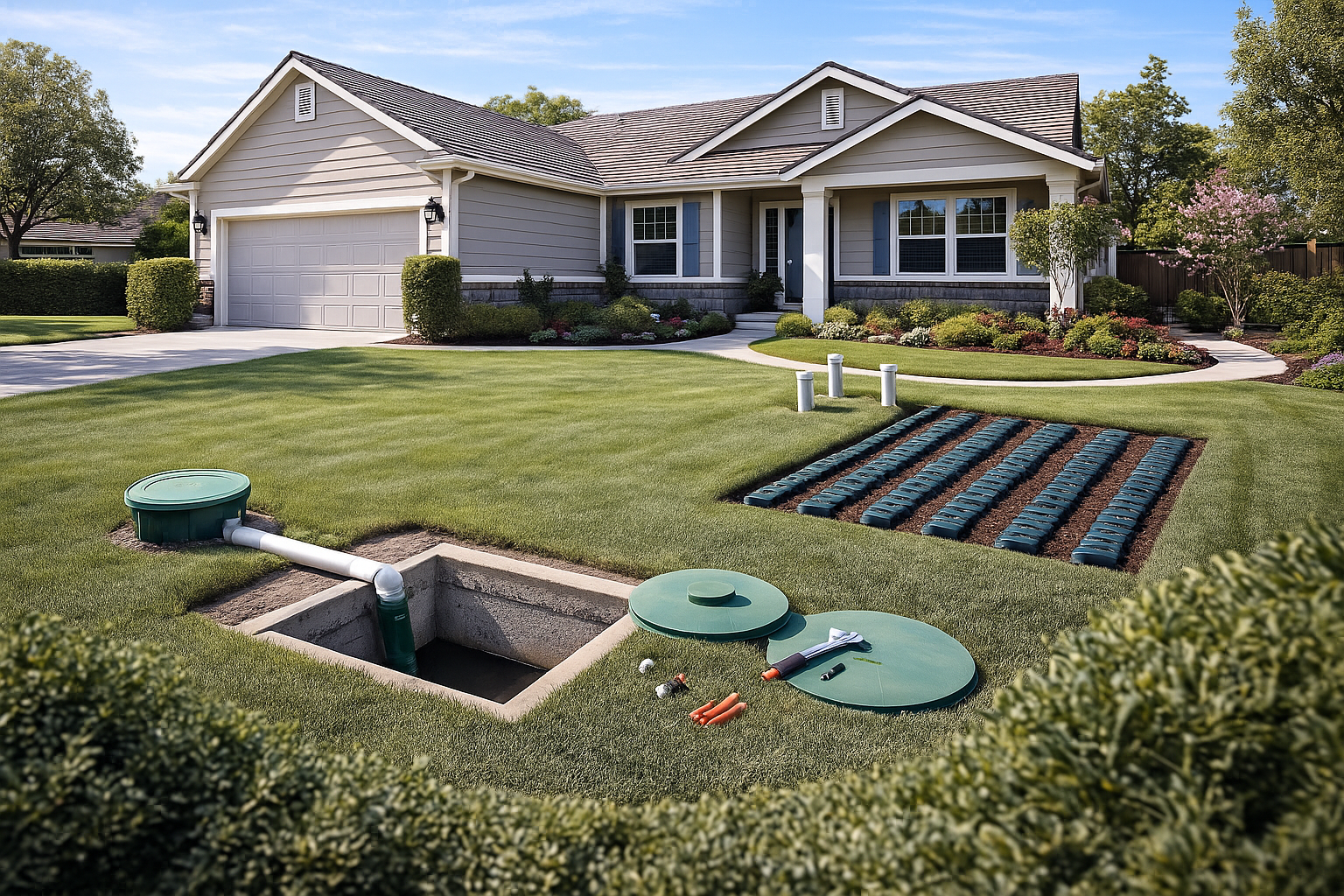Have you ever dreamed of having a picture-perfect backyard, only to feel stuck because there’s a septic tank right in the middle of it? You’re not alone—many homeowners struggle to balance curb appeal with the practical realities of septic system care. The good news? With the right septic tank landscaping ideas, you can have both beauty and functionality without risking your home’s underground system.
How to landscape around septic tank areas is about more than looks—it’s about keeping your system safe, functional, and protected. The wrong plants or materials could lead to costly repairs, while the right choices—such as safe plants near the septic drain field or the best grass for septic fields—keep your system healthy and your outdoor space appealing.
For a deeper understanding of how maintenance and design go hand in hand, you can also explore our guide on septic pump-outs and how pump trucks work. Smart garden design septic tank strategies combine creativity and safety, ensuring your landscaping works with your system, not against it. Following these principles allows you to enjoy a sustainable, functional, and stunning outdoor space that enhances your home’s value and safety.
A Brief Background on Septic Systems and Landscaping
Septic systems have existed for over a century and remain essential for millions of homes today. As communities expand and homeowners invest in outdoor beauty, landscape design septic tank area planning has become increasingly important. A septic system, composed of a tank and drain field, safely processes wastewater underground. But its efficiency depends heavily on what you plant and build above it.
Homeowners today are more eco-conscious than ever, making backyard septic tank landscaping a growing trend. While some assume septic systems limit creativity, modern approaches—such as using low-maintenance plants for septic fields and septic tank cover landscaping—combine practicality and aesthetics. Avoiding common septic tank landscaping mistakes, like planting deep-rooted trees or permanently covering lids, can prevent serious repair costs.
Additionally, understanding septic tank pump-out regulations helps homeowners comply with local laws while maintaining a healthy system. Effective landscaping not only improves yard safety but also disguises lids using removable covers or natural elements. By following a detailed septic system landscaping guide, you’ll protect your system, comply with regulations, and keep your property looking beautiful year-round.
Understanding the Basics of Septic Tank Landscaping
At its core, septic tank landscaping is about finding balance between beauty and function. You want a visually appealing yard that also protects what lies beneath. Every decision—from planting near septic system zones to managing soil grading—affects the performance and lifespan of your system.
Here are the foundational principles of septic-friendly landscaping:
- The Septic Tank and Drain Field: Keep them clear of heavy structures. Proper septic field maintenance prevents system overload and extends lifespan.
- Root Systems: Choose shallow-rooted plants like ornamental grasses and perennials for septic drain field areas.
- Soil and Drainage: Maintain proper grading to encourage water absorption and minimize erosion.
- Accessibility: Hide septic tank lids with decor but ensure easy access for inspections or pump-outs.
For more insights, check out the risks and benefits of DIY septic tank pump-outs to understand why professionals recommend leaving maintenance to experts. By applying these principles, you’ll design a landscape that looks beautiful while protecting your system below ground.
The Benefits of Smart Septic Tank Landscaping
A well-planned septic tank landscaping strategy offers both visual appeal and practical protection. Beyond preventing damage, it enhances property value, supports environmental health, and simplifies maintenance.
Here’s what you gain from a smart design:
- Protects Your Investment: Prevents cracks, leaks, or flooding that can lead to costly repairs.
- Boosts Curb Appeal: Creative septic tank cover landscaping hides system components naturally.
- Simplifies Maintenance: Proper access points make septic field maintenance easier.
- Improves Environmental Health: Shallow-rooted plants improve filtration and groundwater safety.
- Adds Peace of Mind: A well-maintained yard minimizes odor and system stress.
If you live in a flood-prone area, review our article on protecting your septic system during heavy rain and flooding. These strategies complement your landscape design by ensuring your septic setup remains efficient during extreme weather. With the right plan, your yard becomes a seamless blend of beauty, protection, and sustainability.
The Challenges of Landscaping Around Septic Systems
Even the most stunning yards face limitations when built around septic systems. You can’t place patios, driveways, or pools above your system—but that doesn’t mean you can’t get creative.
Here are common challenges and how to solve them:
- Design Limitations: Avoid heavy structures, but embrace septic tank slope landscaping for added visual appeal.
- Maintenance Access: Keep lids accessible using mulch or lightweight stones.
- Drainage Problems: Ensure grading directs water away from drain fields.
- Plant Restrictions: Avoid trees near septic tanks to prevent root intrusion.
Another often-overlooked challenge involves confusion between septic systems and grease management setups. Learn the key differences in grease traps vs. septic tanks to ensure your property’s wastewater system is properly maintained. By combining creativity with awareness, you can design a landscape that looks great and keeps your system safe for decades.
How to Put Septic-Safe Landscaping Into Action
Now that you understand the essentials, it’s time to put your septic tank landscaping do’s and don’ts into action. The goal is to balance visual beauty with structural protection.
Here’s a practical step-by-step approach:
- Map Your System: Locate your tank, drain field, and access lids.
- Set Boundaries: Mark areas where you shouldn’t build or plant deep-rooted vegetation.
- Choose the Right Plants: Opt for low-maintenance plants for septic fields.
- Design for Access: Use decorative stones or mulch to cover lids attractively.
- Plan for Drainage: Proper grading prevents pooling and over-saturation.
- Maintain Consistently: Schedule regular inspections and pumping.
For a deeper dive into protection methods, visit our guide on how to protect your septic system during heavy rain and flooding. These preventive steps help preserve both your landscape design and your system’s long-term health.
The Future of Septic-Safe Landscaping
Modern landscaping now embraces innovation, sustainability, and technology to protect septic systems. As awareness grows, more homeowners are adopting smarter, eco-friendly solutions.
Emerging trends include:
- Smart Monitoring Systems: Real-time sensors detect septic performance issues early.
- Eco-Friendly Planting: Native plants support local ecosystems and reduce maintenance.
- Design Integration: Builders now plan landscape design septic tank areas during home construction.
- Creative Hardscaping: Lightweight, decorative structures enhance functionality.
- Improved Drainage: Innovative materials prevent flooding and erosion.
Municipalities are also updating their septic tank pump-out regulations to encourage more sustainable practices. These forward-thinking standards make future yards more efficient, beautiful, and environmentally responsible.
Bringing It All Together
Septic tank landscaping do’s and don’ts focus on balancing aesthetics, protection, and longevity. Your outdoor space can look amazing while safeguarding your septic system.
Keep these tips in mind:
- Follow septic tank landscaping rules to avoid costly damage.
- Maintain proper soil grading to promote drainage and system health.
- Choose decorative yet functional features like flower beds or small garden ornaments.
Avoid septic tank landscaping mistakes like deep-rooted trees or permanent covers. Instead, embrace flexibility and creativity to design a sustainable space. For guidance on professional maintenance, review our insights on septic pump-outs and truck processes to ensure your landscaping plans complement your pumping schedule.
Final Thoughts and Next Steps
Septic-safe landscaping is more than an aesthetic choice—it’s about harmony between design, function, and environmental care. From lawn care over septic systems to garden design septic tank planning, every decision affects your home’s safety and appearance.
Ready to take the next step? Explore more landscaping ideas, talk to professionals, and monitor for early signs of septic system issues. If you’re considering doing maintenance yourself, understand the risks and benefits of DIY septic tank pump-outs before getting started.
By embracing these septic tank landscaping do’s and don’ts and practicing smart care, you’ll enjoy a greener, healthier, and more sustainable yard that enhances your home’s long-term value.






